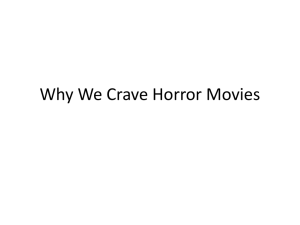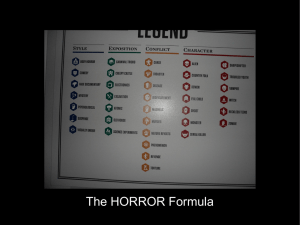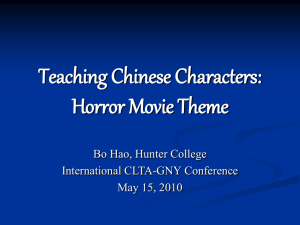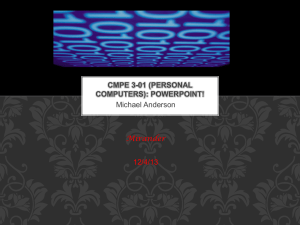Answers Why We Crave
advertisement
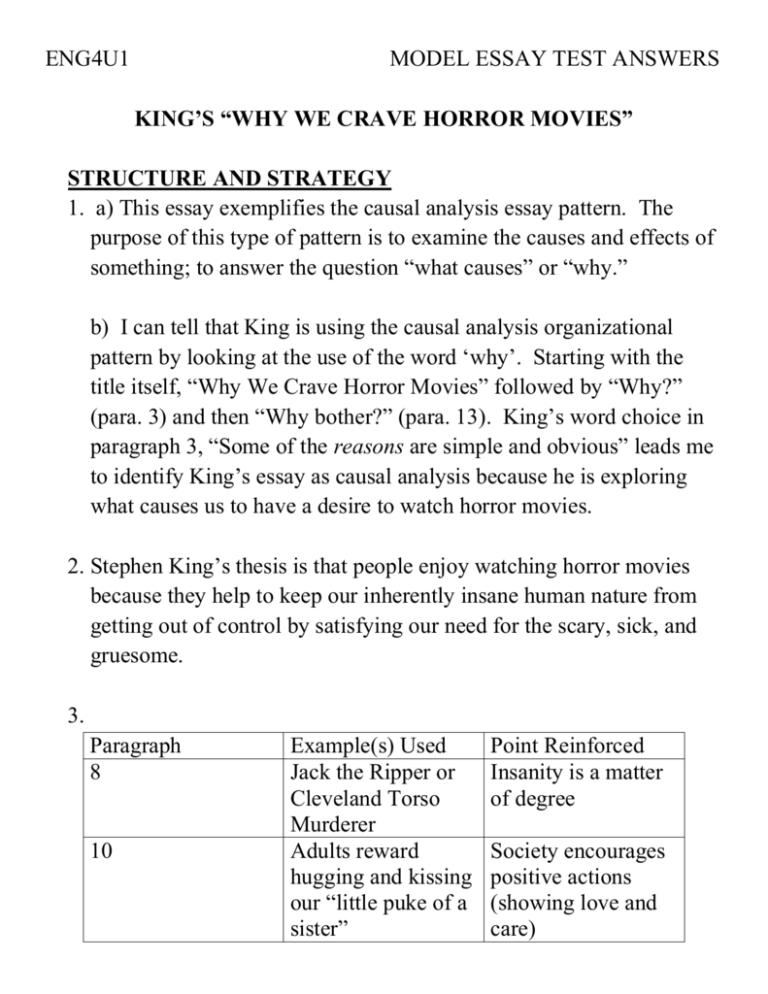
ENG4U1 MODEL ESSAY TEST ANSWERS KING’S “WHY WE CRAVE HORROR MOVIES” STRUCTURE AND STRATEGY 1. a) This essay exemplifies the causal analysis essay pattern. The purpose of this type of pattern is to examine the causes and effects of something; to answer the question “what causes” or “why.” b) I can tell that King is using the causal analysis organizational pattern by looking at the use of the word ‘why’. Starting with the title itself, “Why We Crave Horror Movies” followed by “Why?” (para. 3) and then “Why bother?” (para. 13). King’s word choice in paragraph 3, “Some of the reasons are simple and obvious” leads me to identify King’s essay as causal analysis because he is exploring what causes us to have a desire to watch horror movies. 2. Stephen King’s thesis is that people enjoy watching horror movies because they help to keep our inherently insane human nature from getting out of control by satisfying our need for the scary, sick, and gruesome. 3. Paragraph 8 10 Example(s) Used Jack the Ripper or Cleveland Torso Murderer Adults reward hugging and kissing our “little puke of a sister” Point Reinforced Insanity is a matter of degree Society encourages positive actions (showing love and care) 11 Jokes about truckload of bowling balls/dead babies We need to exercise our uncivilized emotions and urges 4. The tone of King’s essay is humorous and playful. He engages the reader with humour to prove his point. For example, he shares jokes like “What’s the difference between a truckload of bowling balls and a truckload of babies?” (para. 11) and even encourages us to laugh with him at times by including his own laugh track “heh-heh-heh” (para. 8). He also provokes a smile when he makes fun of people, as he does when he refers to “the verses (I don’t dare call it poetry) of Leonard Nimoy” (para 9). CONTENT AND PURPOSE 1. a) The three “simple and obvious reasons” why we like horror movies are: “to show that we are not afraid” (para 3), “to re-establish our feelings of normality” (para 3), and “to have fun” (para 5). b) The less obvious reason that King develops in paragraphs 7 – 12 is that we all have uncivilized emotions and urges, deep down within ourselves, that every once in a while need to be let out. We enjoy horror films because they fulfill this demand that we have of temporarily releasing our inner demons, thereby satisfying our socially unacceptable urges. 2. The analogy that is the basis of paragraph 9 compares emotions to muscles that make up a body. It reinforces the idea that watching horror movies is a normal, healthy activity because those films exercise those uncivilized, fearful emotions that constitute part of the body. If we don’t exercise those muscles, then we will lose tone and be unable to keep those emotions in check. 3. a) Personification is giving inanimate objects (non-human things) human characteristics or abilities. b) The horror movie is being personified. It “has a dirty job to do.” A film is being given the human ability to do a job, which it can’t do. 4. The “hungry alligators” referred to in paragraph 12 represent the insane side of people and uncivilized emotions/urges that King describes. This is a very effective analogy because alligators are dangers and vicious just like human insanity can be, and having them “swimming around” (para 12) implies that they, like our insane sides, are restless and wanting to get out. “Throwing a basket of raw meat” is an unpleasant action, much like watching a horror movie can be an unpleasant process, but it is necessary to keep the gators from getting out (like insanity). This effectively communicates the nature of human insanity and the purpose that watching a horror movie serves: to feed the gators, to satisfy those socially unacceptable cravings for violence.
